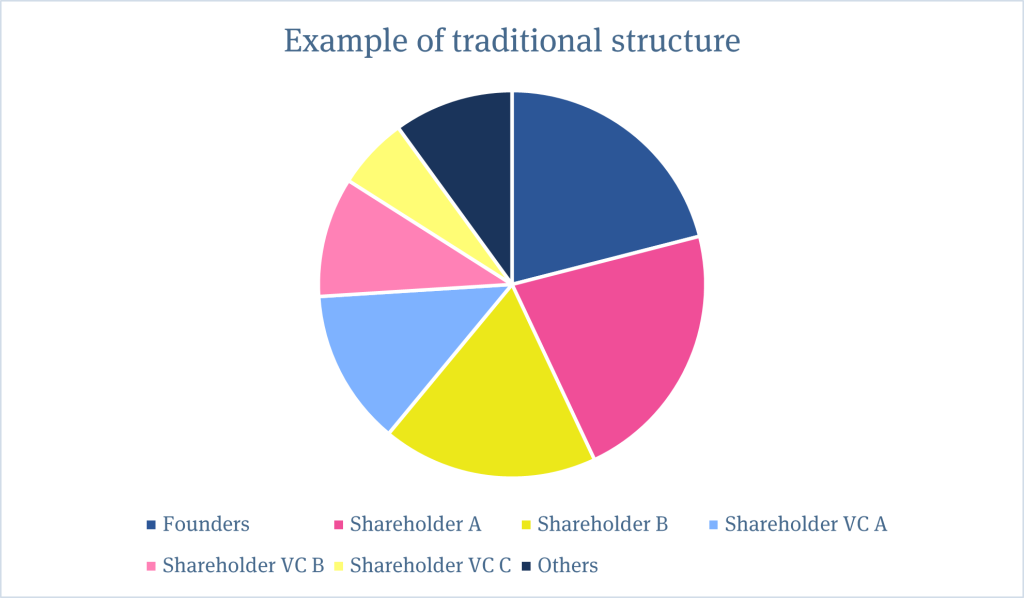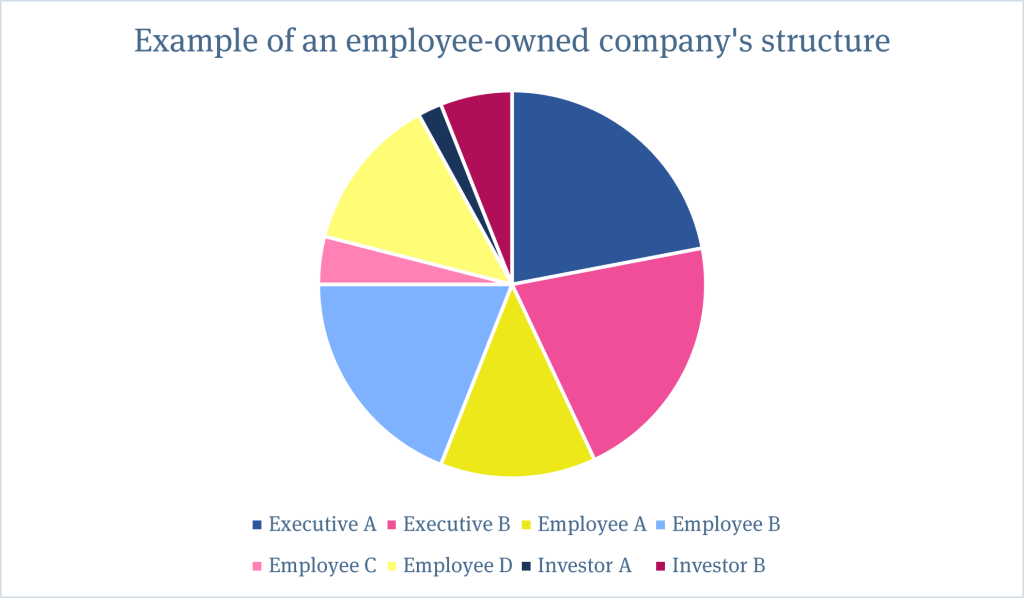Common ownership of companies is a win-win for all: workers, economy, society and environment. The following publication describes a novel idea of ownership structure of the company, its impact on the company itself, its workers and other stakeholders, economy and environment.
Introduction
Companies are like other organizations – they are built by the people for the people. It is hard to imagine a company that is working on creating solutions, providing services, delivering products to not interact with stakeholders – in this case, with customers. It would be definitively not wise to think about a company that interacts with customers only. As we know, the company is operating in an environment where we can find different actors.
The main stakeholders of companies are:
- Executives
- Employees
- Shareholders
- Partners
- Customers
- Regulators
- Organizations
- Media
- Society
Among those groups there are three important stakeholders that have influence over the company: executives and employees, and shareholders. We all know that the company is owned by shareholders or a single owner. We also know that executives handle daily management, running the business. It is possible to find a lot of information that C-level executives are achieving successes, building the value of the company, etc. Shareholders are mentioned for many times too, especially when the company is successful, we can find headlines and articles in the press about specific shareholders, for example, major shareholder or investors.
However, by mentioning only these two groups, employees are forgotten. Why? Because they are not considered as important stakeholders as shareholders and executives. We don’t see mentions like “sales specialist at company X made a huge impact on company’s sale revenue”, “marketing specialist helped in optimizing company’s digital operations” or “designer created new website that hugely impacted conversions that led to new deals”.
It is too often forgotten that employees play a key role in companies. It is not possible to build a strong company without employees because the company is always built by the people. These people are not just executives and shareholders, but primarily employees. To be clear, both C‑level executives and employees at the lowest level are employees.
The main issue with forgetting about people who create the true value is that these people don’t benefit from creating it. Most bonuses, bonus shares, stock and stock options are available to high-level executives, not to all people who engage in building the company and making it successful. This issue creates other issues and contributes to the alarming rise of the inequality and huge concentration of wealth in the hands of few people.
Now of writing this publication, there are two main principles of ownership of companies: ownership by founders and ownership by rich people. Both principles negatively affect the society, economy, and wellbeing. It creates a huge concentration of wealth, including capital income and capital ownership.
Top earners are winners because of capital ownership
When we think about top earner, we see someone who receives a huge amount of money each month. However, it is important to look on details – top earners are the only winners because of capital ownership and capital income because of this ownership.
The pay of top earners consists mostly of stock options and stock grants that give them a share of the increased growth and income that comes from capital. Who are the top earners? Executives as their pay is based on base salary, stock options and stock grants, profit-share, and other incentives. In meantime, other employees’ pay is based on salary. It is easy to say that executives are taking all risks, but to be clear and honest, employees are also taking risks. If the company collapses and goes bankrupt everyone looses.
| Compensation package comparison | ||
| Compensation type | Executives | Employees |
| Base salary | Yes | Yes |
| Pay based on company’s performance | Yes | No |
| Profit-sharing | Yes | No |
| Stock bonuses and awards | Yes | No |
| Stock options awards | Yes | No |
| Perks | Yes | Partially yes |
Compensation package comparison

Today, the main issue that drives inequality is simple: a huge concentration of wealth, including capital income and capital ownership. There is only one way to solve this issue – implement stock ownership by employees to create common ownership.
Common ownership is a win-win for all
Common ownership – stock ownership for all employees, not just executives and investors – is the only way to fight inequality and deliver means of created value to all people involved in creating such value.
Stock ownership for workers is beneficial for all employees, their families, and the whole company. There is no sense in following the rule that employees and executives are two groups with different priorities and interests because it is in common interest to create the true value and make the company thrive.
Common ownership is based on creating and expanding stock ownership and capital income for workers and encouraging broad-based employee ownership of the company, making widely available profit-sharing and making stock options and bonuses available to all employees, not just high-level executives.
This model creates the following structure of the company:
- All employees at the company – workers and executives – are the same group, and both workers and executives are shareholders.
- The company’s structure is flat and functional. Unnecessary, complex hierarchical structure is avoided – in general, complex and very hierarchical structures are bad for businesses and workers.
- The management board is accountable to shareholders – all employees. Due to this fact, the management board has better motivation to act in interest of the company as an organization of commons interests.
- Workers and executives are not enemies to each other. They have the common values, mission, interests and objectives. These two groups do not fight each other and work together to build and grow the company.

In this example we assume that all people in the company decided to take shares depending on their wish.
The company itself is an organization that ensures the wealth is distributed fairly and benefits all people. In employee-owned company there is no conflict between the leadership and workers, and workers are free to decide whether to form union or not – such union can function as a group of advisors to the management board and by doing so, help in improving the company.
By implementing common ownership, the company can become the force of good that will affect positively many aspects of workers’ life. Employees will benefit from the value creation and capital ownership through the profit-sharing and capital income which will help them in avoiding debt trap, financial struggles. Mental issues will be avoided too because of no key factors such as mentioned ones.
Employee-owned company is a company that benefits employees’ families as well. By creating wealth for workers, the company creates wealth for their families too. Common ownership enables financing the wellbeing and other expenses of family members. For example, the wealth created from the capital income can be used to pay for education, ensure financial security of parents and their children. Employee-owned company is a good place to work at also for students – by creating a flexible, friendly working environment and sharing profits students can work and educate themselves without worrying about how to fund their education by avoiding negative schemes such as loans affecting the future life of each student (student debt trap). Employee-owned companies can even create purposeful measures to support employees in harder time through profit-sharing and creating solidarity among workers.
Employee ownership and employee participation positively affects the company and its performance and wealth creation. The wealth creation is beneficial to the whole company: both workers and executives.
Common ownership is people-first
Common ownership is not just about stock ownership for all workers. It is about common mission and values, including core values. Here, we are talking about the model of people-first company. People-first companies are companies that value people, put people before maximization of profits at all costs. People-first company will create value for all people involved in building the company. Creating a company that is perceived by employees as their company will have an enormous impact on their engagement, wellbeing and economic safety and success of all people in the company.
Let’s imagine a people-first company. It is a company in which workers are happy to work at because they work together to create the true value and commercial success with positive social impact – both are driven by common mission and values.
The execution is combined with humanity and the management board is integrated with the workplace, not isolated, nor bureaucratic. The management board acts as the group of leaders with CEO or chairperson as the main leader. The leadership is based on trust, empathy, experience, sharp vision and responsibility, not on mobbing and bullying. The aim of a strong leadership in a people-first company is to manage the company to achieve the success, build friendly, open, and collaborative working environment, treat people with respect and dignity, and inspire people.
In the people-first company, the decision making is transparent, collaborative and participative. Workers can take part in it without any fear and obstacles. Giving workers an opportunity to take part in decision-making is not a threat to the management board of the company, nor to other shareholders (e.g., investors).
People-first company is more like a community or family – built on trust, solidarity, common sense, mission and values. Organizational culture of the people-first company is primarily based on empathy, transparency, trust between people and values. The company’s culture is open, valuing diversity and valuing people themselves.
Creating common ownership in a company
To create an employee-owned company it is needed to make few steps that involves structuring the company, its processes and organizational culture. While there are many approaches on creating such a company, it is recommended to follow the below steps.
- Creating and expanding stock ownership for workers through implementing the policy about stock ownership for workers program. Such a program should create a framework for creating stock awards and stock options program.
- Encouraging broad-based employee ownership and explaining why it is important and how this will affect the company as an organization of all people.
- Enabling stock options and stock awards for all employees, not just for executives.
- Making widely available profit-sharing. Such scheme can be set up as a policy and applied directly to the compensation package of each employee.
- It is important to inform all employees that the capital income and profit-sharing depends on the company’s performance.
- Promoting common ownership, common values and mission, and vision of the employee-owned company.
These six steps create a straightforward guide to create a strategy for implementing common ownership of the company and creating an employee-owned company.
Common means solidarity
What we do when the member of our family or our friend is in trouble? What we do if that person struggles financially, for example, because of student debt or an accident? We want to help that person. We can see the company just as a workplace, but we need to see that we spent most of our time working at the company, collaborating with other people there. Naturally, we build relationships with people are working there – we have colleagues, friends, we build different relationships. Even the biggest individualist will build relationships with other people. There are companies that tries to restrict such relationships or even restrict communication between people and treats people not as people but as robots, or even something worse.
As we know, people-first companies are companies built on common ownership and people-first approach. Common ownership creates an interesting situation: the company itself is owned by all, is a common good and its success depends on the wellbeing of workers. It is an integral part of each of us to help each other and when one worker faces issues it affects other people directly or indirectly.
Creating a working environment in a commonly owned, people-first company is about creating a supportive environment. Such environment can be created only when the company and its people are helping each other, work together on achieving common goals and to solve not just business problems, but also problems that affects other employees. It is beneficial to integrate culture of solidarity and helping others with the organizational culture. In this way, we can create a working environment that is able to solve issues sometimes even unsolvable for specific person in the team.
As part of integrating and promoting solidarity at all levels at the company, it is wise idea to consider implementing company’s internal policies on promoting solidarity of all people. The company can create a significant move and communicate that it cares about all workers and their wellbeing.
Common ownership is beneficial for society and environment
We know that common ownership creates plenty of benefits for the company and its employees. It is worth noting that common ownership is also beneficial for environment and society. People-first, employee-owned companies are socially and environmentally conscious. Such a company can navigate through social and environmental issues such as human rights (including labor and minority rights), climate, more equal and equitable world for all.
The society can benefit from common ownership in diverse ways. The company can be a force of good and make huge contributions through empowering workers and ensuring financial inclusion for them and their families. For example, making widely available profit-sharing can significantly affect the lives of workers and their families, and create the feeling that the company cares about all. People can finance all expenses, including educational expenses to ensure the high quality of education of their children. Young people can finance their studies from the employment without the need to take loans. Common ownership can create a wide range of income and profits from value creation for all stakeholders and by doing so, it can help in reducing poverty and harm caused by bad financial situation of the people.
Good governance and policies
Common ownership can help in implementing and monitoring good governance practices and standards like environmental, social and governance (ESG), diversity, equity, inclusion (DEI) and good treatment of stakeholders. Common ownership also forces the management board to act responsibly and be accountable. We know that many companies are the source of harm and responsible for unethical behavior, union busting, child labor, modern slavery and destroying the environment. In the employee-owned company it is not possible to use the company to cause the mentioned problems. Common ownership creates people-first company, and the people-first company is a company that won’t cause harm for any group in society.
As the employee-owned company shares the values of all workers, it can promote good practices and relationships like employer-employee relationship, fair compensation policies, open environment, building good relationships between all people working at the company. Such a company can give an example for other companies and workers across the world – and by doing so, to promote common ownership among people everywhere. The company can be a source of knowledge and courage for workers from other companies to help them in moving other companies into this model.
Social impact
As we know, the employee-owned company shares the values and mission of all people who work there. But such as company can also be a vehicle for change, for making positive impact in society. Due to fact that the company is owned by employees and treated as a common good, the company itself promotes solidarity among workers. This can lead to more intensive engagement in activities like supporting the local community, doing philanthropic work, creating good, decent jobs, launching environmentally friendly programs.
In general, there is no long distance between the employee-owned company and social impact company. In fact, employee-owned companies are social impact companies because they contribute to workers and their families’ wellbeing, better access to education for their children and promoting employee activism. Such a company has different points of view which can help in identifying social and environmental issues and finding solutions to these problems. We can easily imagine that the company is able to work on finding the right approach to solve identified issues, and then move to find other problems and solve them. In this model, the employee-owned company is a social impact company, a company that can solve problems that affects local communities, environment, climate, and human rights.
As we know, the traditional profit-centered ownership tends to put profits before people, society, and planet, while employee ownership can significantly affect the approach of the company because of more accountability and ethical leadership that values sustainability. Employee owners, due to company’s culture, are highly likely to make the company’s values a reality and steward the mission. By contract, the traditional profit-centered ownership will focus on driving out any mission and values other than profit maximization.
Ethical leadership that drives sustainability is supported by people-first approach, company’s mission and values. According to the research conducted Fifty by Fifty, 57 employee-owned and mission-driven companies effectively designed their structure to drive their growth while addressing major issues such as growing inequality and climate crisis.
Civic investments and poverty eradication
Common ownership is a novel model that can enable citizenship investing, a real alternative to unfair practices of using public funds to bail-out big corporations and subsidy companies that cause harm to people and environment. For example, there is no reason to bail-out a company as the public won’t have any benefits from such an act. Will citizens get dividend or other profits because of pouring money to large corporations? No, in fact, their money will be used to incentive irresponsibility of such corporations’ executives and shareholders who put profit before people and don’t give anything in return.
With common ownership, public and personal funds are used to invest in companies to support their growth and get return of investment. Return of investment itself can have many forms. For example, creation of decent, good jobs, dividends, profit-sharing and other kinds of positive social impact. The biggest return of investment is in fact poverty eradication as all people can benefit from common ownership and business model that is focused on sustainability, economic growth beneficial for all and creating people-first, inclusive economy.
Common ownership is beneficial
There is no doubt that common ownership of companies means creating a structure that will benefit all workers, both ordinary employees and executives. It can create a healthy balance between all stakeholders and ensure the company’s direction is based on the people-first principle and common mission and values. The company itself can thrive due to being a common good of all employees that benefits all, not just the few. By implementing effective and employee-friendly stock options and stock award programs combined with profit-sharing model, the company can ensure the wellbeing of all workers and their families.
Common ownership is also a solution to address the growing inequality and corporate wrongdoing. Employee ownership leads to accountability of all stakeholders and ensures that executives are acting ethically by putting people before profit maximization at any costs. As a results, the company becomes socially conscious and environmentally responsible.
Common ownership and people-first principles can finally end the age of poverty and rising inequality by creating an inclusive economy that put people first, not profit maximization. Common ownership is a sustainable model that benefits all, not just the few.

